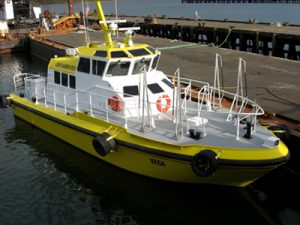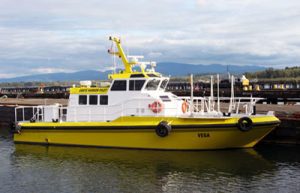
The 54.5-foot aluminum pilot boat Vega represented the latest ideas in design and propulsion when it arrived at Jacobsen Pilot Service in the Port of Long Beach in Los Angeles County in 2003. After 15 years of daily service, it was replaced in 2018 by the Orion, a 63.5-foot custom design with a fiberglass sandwich hull that provides insulation from noise and vibration.
The Vega was put up for a sale at a price of around $400,000, but did not attract a buyer until the summer of 2020 when the Port of Grays Harbor, Wash. took advantage of this opportunity to modernize its pilot service.
Grays Harbor is the only commercial port on Washington’s Pacific Coast, where dangerous conditions often occur at the entrance, especially during winter gales. Two experienced pilots are available to handle 1-2 ships a week, carrying soy meal and wood products for export. They relied on a traditional steel pilot boat, the 60-year-old Chehalis, with a displacement speed of 10 knots. The pilot boat service is operated and maintained by Brusco Tug & Barge, based in Longview, Wash. on the lower Columbia River, which also provides tug service to the port.
The port had been looking to bring in a boat with higher performance for some time. “We started with the idea of looking at used boats just because of the high cost,” port Director of Health, Safety & Environment Randy Lewis explained to the local newspaper, The Daily World. “We checked with other ports and pilot associations to see what they were running and found the cost of a new custom-built aluminum boat suitable for the task would have run $5 million to $8 million, while a standard design boat could easily have run $2-3 million.”
Then he learned the Vega was for sale at a significantly lower price than the Port Commission expected. Fortunately, the hull was built by Hike Metal of Ontario, Canada with 3/8″ plate and five watertight compartments for a minimum service life of 30 years, according to the builders. Hike typically supplies boats to withstand the harsh winter conditions on the Great Lakes, so the hull showed very few signs of serious wear and tear after its years of daily use in Southern California.
The design features a shallow-V hull with a resiliently mounted superstructure to reduce noise levels in the pilot house, which is raised above the aft seating area for a better all-round view for the helmsman. The bridge was laid out ergonomically and is equipped with a central wheel and Kobelt jog stick, with additional port and starboard stations each with a jog stick and throttle controls. The navigation screens, engine information and switches were all positioned within arms’ reach of the Bostrom helmsman’s chair on the centerline. (Hike had hired E.Y.E. Marine Consultants located in Bedford, Nova Scotia to perform the detail work and production engineering.)
Even with the shutdown due to COVID, the port was able to complete an initial inspection in California in July of 2020 as part of their due diligence process. After initial trials in the fall of 2020 by Brusco’s port captain, Troy Irving, and senior pilot Robert Dangelo, several safety upgrades and modifications were identified to withstand the harsh conditions when coming alongside ships off the Grays Harbor entrance.

It was decided that the Vega needed a continuous set of handrails from the foredeck to the transom steps, new raised boarding platforms on both sides of the bow, and a transom step before it could function safely in all weather conditions.
WCT Marine in Astoria, Oregon was selected to haul the 44-ton boat out, add the safety upgrades and perform a full inspection and overhaul. The list of work below the waterline included a significant amount of hull maintenance: removing the 3 ½” Aqualoy 17 shafts and 6 x 36″ four blade NIBRAL propellers for servicing, fitting line cutters and reconfiguring and recalibrating the Electro Guard anti-corrosion system to operate correctly in the brackish waters of Grays Harbor.
In the engine room, the Vega was originally powered by two Detroit Diesel (MTU) 12V2000 engines rated at 965 bhp at 2,100 RPM turning twin propellers, giving a top speed of about 25 knots. Jacobsen had repowered the boat in 2011 with more powerful Tier 2 Caterpillar C32 ACERT V-12’s, with a maximum output of 1300 bhp at 2100 rpm, raising the top speed to almost 30 knots. Although they’d logged over 8,000 hours, they were found to be in good condition.
All the mechanical systems, including the 9 kW Northern Lights gen-set, ZF 3050 A 1.75:1 reduction gears, were checked and serviced, plus the 800-gallon main fuel tank with a leak that was repaired and pressure-tested.
In the pilothouse, the electronics package was upgraded, but the original layout was retained. The old cabling and some antennas were removed, and Navsource Marine Electronics of Vancouver, Wash. installed a full suite of Furuno NMAE 2000 navigation electronics, comprising two Furuno 1945 radars—4kW and 6kW, SCX-20 Sat compass, GP 330 Bravo V unit, smart depth sounder and ComNav 1000 auto pilot — all running on Coastal Explorer software.
The Vega was originally fitted with a continuous D-rubber fender attached by an internal wire tensioner that had proved satisfactory in Southern California. But to withstand the winter weather off the Grays Harbor entrance, six pairs of double-stacked aero tires were added, four pairs around the bow and two at the stern. They were secured on top of the D-rubber with heavy webbing to new eye plates. The heavy framing in the hull-deck joint also facilitated the addition of the new aluminum stanchions.
The boat was then trialed at the mouth of the Columbia River, and delivered back to Grays Harbor by Irving.
“The final result of this unusual project by the Port of Grays Harbor, Brusco Tug and Barge and WCT Marine is a pilot boat in remarkably good condition, considering its age, and equipped to handle our local waters at a significantly reduced cost,” said Lewis. “The Vega is now configured to meet our operational requirements and safely operate in our waters. It can withstand comparison with the newer craft used in the other ports on the Northwest coast.”
WCT’s owner and manager, Willie Toristoja, was also very satisfied with the final product.
“The Grays Harbor pilots now have a high-speed boat that will give them many years of reliable service,” he said.

